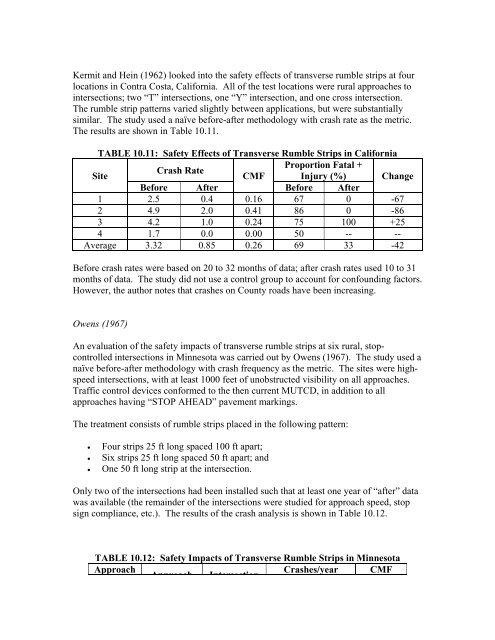Synthesis of Safety for Traffic Operations - Transports Canada
Synthesis of Safety for Traffic Operations - Transports Canada
Synthesis of Safety for Traffic Operations - Transports Canada
You also want an ePaper? Increase the reach of your titles
YUMPU automatically turns print PDFs into web optimized ePapers that Google loves.
Kermit and Hein (1962) looked into the safety effects <strong>of</strong> transverse rumble strips at four<br />
locations in Contra Costa, Cali<strong>for</strong>nia. All <strong>of</strong> the test locations were rural approaches to<br />
intersections; two “T” intersections, one “Y” intersection, and one cross intersection.<br />
The rumble strip patterns varied slightly between applications, but were substantially<br />
similar. The study used a naïve be<strong>for</strong>e-after methodology with crash rate as the metric.<br />
The results are shown in Table 10.11.<br />
TABLE 10.11: <strong>Safety</strong> Effects <strong>of</strong> Transverse Rumble Strips in Cali<strong>for</strong>nia<br />
Proportion Fatal +<br />
Crash Rate<br />
Site<br />
CMF Injury (%) Change<br />
Be<strong>for</strong>e After<br />
Be<strong>for</strong>e After<br />
1 2.5 0.4 0.16 67 0 -67<br />
2 4.9 2.0 0.41 86 0 -86<br />
3 4.2 1.0 0.24 75 100 +25<br />
4 1.7 0.0 0.00 50 -- --<br />
Average 3.32 0.85 0.26 69 33 -42<br />
Be<strong>for</strong>e crash rates were based on 20 to 32 months <strong>of</strong> data; after crash rates used 10 to 31<br />
months <strong>of</strong> data. The study did not use a control group to account <strong>for</strong> confounding factors.<br />
However, the author notes that crashes on County roads have been increasing.<br />
Owens (1967)<br />
An evaluation <strong>of</strong> the safety impacts <strong>of</strong> transverse rumble strips at six rural, stopcontrolled<br />
intersections in Minnesota was carried out by Owens (1967). The study used a<br />
naïve be<strong>for</strong>e-after methodology with crash frequency as the metric. The sites were highspeed<br />
intersections, with at least 1000 feet <strong>of</strong> unobstructed visibility on all approaches.<br />
<strong>Traffic</strong> control devices con<strong>for</strong>med to the then current MUTCD, in addition to all<br />
approaches having “STOP AHEAD” pavement markings.<br />
The treatment consists <strong>of</strong> rumble strips placed in the following pattern:<br />
• Four strips 25 ft long spaced 100 ft apart;<br />
• Six strips 25 ft long spaced 50 ft apart; and<br />
• One 50 ft long strip at the intersection.<br />
Only two <strong>of</strong> the intersections had been installed such that at least one year <strong>of</strong> “after” data<br />
was available (the remainder <strong>of</strong> the intersections were studied <strong>for</strong> approach speed, stop<br />
sign compliance, etc.). The results <strong>of</strong> the crash analysis is shown in Table 10.12.<br />
TABLE 10.12: <strong>Safety</strong> Impacts <strong>of</strong> Transverse Rumble Strips in Minnesota<br />
Approach<br />
Crashes/year CMF<br />
Approach Intersection
















